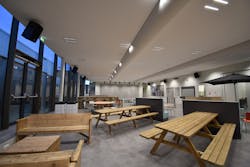Dutch wireless smart lighting software company Ingy has purchased 100,000 licenses to the Wirepas mesh protocol, which it is embedding in its own controls software — a volume deal that it hopes will drive down prices across the value chain and boost end-user uptake.
Ingy is off to a good start with the strategy, as it has resold half of the licenses to luminaire maker Koopman Interlight.
The other 50,000 could go to luminaire makers or to lighting companies that make luminaire components such as sensors, drivers, and chipsets. “There will be more announcements,” Ingy CEO Bastiaan de Groot told LEDs Magazine.
Ingy’s software on its own supports a myriad of wireless controls functions such as on/off, daylight harvesting, scene management, commissioning, and spectral tuning. It does not natively include support for mesh operations — wide-scale deployment across sprawling areas.
For mesh, Ingy has for a couple of years turned to Tampere, Finland-based Wirepas, which has developed a mesh protocol for Internet of Things (IoT) networks of all sorts, not just for lighting.
Around this time last year, Ingy strengthened its commitment to help integrate the Wirepas mesh protocol into lighting systems. At the time, de Groot expressed a strong preference for Wirepas over other mesh protocols such as Bluetooth and Zigbee, citing what he describes as superior scaling capabilities.
Now Ingy — which during COVID-19 times has relocated from Amsterdam to Wijk bij Duurstede — has redoubled its Wirepas resolve by purchasing the 100,000 licenses.
De Groot declined to reveal how much he is paying for the licenses, but he said the volume commitment provides a lower price that will filter through the value chain and thus encourage users to invest in wireless mesh controls. High prices have been a prohibitive factor, he said.
Koopman Interlight, also based in Wijk bij Duurstede, has partnered in the past with Ingy on installations at University Medical Center Utrecht, and to Zone.college, a modern eco-oriented school in Doetinchem, Holland. Ingy has now committed to 50,000 copies of Ingy software with the Wirepas protocol. The Interlight luminaires make use of Bluetooth wireless communication chips from Norway’s Nordic Semiconductor, but they support Wirepas mesh rather than Bluetooth mesh.
Interlight director Casper Vulling said that some of the first luminaires under the new arrangement will be headed to a customer in Denmark, which he declined to identify. He also stopped short of saying how soon Interlight plans to build the 50,000 luminaires, or where they might be heading.
“We’ve taken the 50,000 licenses, and we plan to use them all, of course,” Vulling told LEDs.
Some customers appear to have been balking at increasing their taster commitment to smart lighting. Lower prices could help.
“We already have projects, and we hope this is going to be an accelerator,” Vulling told LEDs.
In addition to Interlight, British sensor maker Danlers and Finnish controls and driver maker Helvar are likely candidates to build more Wirepas-enabled gear under the new, less expensive licensing deal. Both are existing Ingy customers. French energy services provider Engie, an existing Ingy partner, might also up its Wirepas game to its end users.
De Groot said Ingy is working with companies from “across the ecosystem,” which includes makers of drivers, controls, and other components. He declined to identify other companies that have increased their commitment under the new pricing but suggested that he could make those names public soon.
The new pricing could be a boost to Ingy’s intentions to make lighting controls more affordable to end users. LEDs described that strategy two years ago as “come for the smart lights, stay for the smart building.” In one approach, an end user on a limited budget could install smart lighting controls that, at a later date, would be capable of also performing smart building operations such as tracking assets or analyzing space usage.
In some instances, the opposite could happen: End users could tap Ingy technology for smart building purposes independent of the lighting system, and then add smart lighting later.
MARK HALPER is a contributing editor for LEDs Magazine, and an energy, technology, and business journalist ([email protected]).
For up-to-the-minute LED and SSL updates, why not follow us on Twitter? You’ll find curated content and commentary, as well as information on industry events, webcasts, and surveys on our LinkedIn Company Page and our Facebook page.





